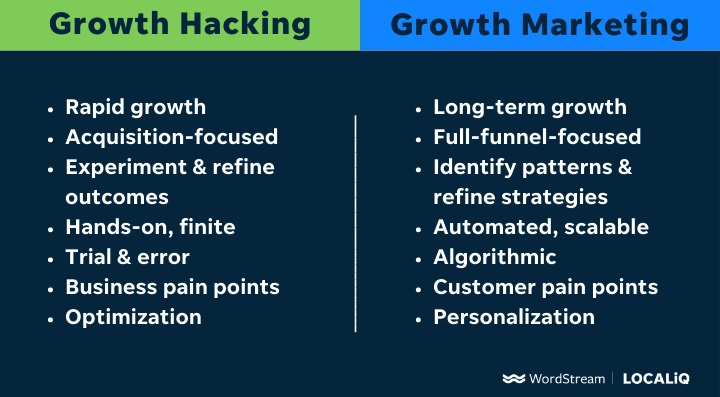In an increasingly competitive environment, companies need to find efficient, innovative marketing strategies. But here’s the deal: gaining a large number of customers within the least amount of time may just not be good enough for successful growth. What you need is to inscribe this growth into a long-standing strategy by promoting customer loyalty, leveraging their feedback, and growing your revenue progressively. That’s what Growth Marketing is all about. This approach combines the creativity and effectiveness of Growth Hacking with the solidity and resiliency of long-term organic strategies (SEO, inbound marketing, and the like). What exactly is Market Growth? Definition, principles… Here’s all you need to know about this key marketing concept.
What Is Market Growth? Definition
The expression “Growth Machine” refers to a strategy whose aim is to help a business grow in as timely and durable a way as possible. The idea is to deploy marketing techniques centred around the customer to understand their sales cycles, to analyze how they behave over the course of their customer journey and, ultimately, to optimize every step of this journey in order to boost performance. Market growth, by definition, can be achieved by any means necessary.
We might as well be clear, there’s nothing revolutionary about Growth Marketing. Rapid growth is an objective that most marketing strategies share, and the various components of this approach (as we’ll see below) have long been used by marketers. Where Growth Marketing differs is in its mindset: Implementing such a strategy is an innovative, creative, and decidedly customer centric undertaking. And it is willing to do away with conventions if it means reaching the goal.
Growth Marketing as an Extension of Growth Hacking
The resemblance between these two approaches is no coincidence. That’s because Growth Marketing borrows some fundamental principles from Growth Hacking all while focusing on fixing its flaws.
Once considered either a huge disruption in the world of marketing or a buzz word with no true substance, Growth Hacking is actually more of a philosophy. It subscribes to the notion that when it comes to marketing, a growth strategy can use any means necessary to achieve its end. The idea is to grow a business in as little time as possible, by thinking outside the box or by utilizing more aggressive methods. Originally, the expression applied to the development strategies used by tech start-ups. A Dropbox employee is even credited for it.
As effective as it may be, Growth Hacking has two main limitations:
- It’s a very short-term approach, whose goal is to generate immediate sales without thinking about the future of the company. For that reason, a Growth hacker is not above using intrusive techniques, such as bulk email marketing, which conflicts with the customers’ wishes and goes against the way general data protection regulations (GDPR) are evolving.
- It’s a strategy that mainly addresses the needs of younger organizations, such as start-ups, which have to rely on significant and timely growth to gain a foothold on their markets. Growth Hacking gets them there by focusing on ROI and often resorts to paid campaigns (Google Ads, social ads, etc.).
Growth Marketing is a growth strategy with very different methodologies and ambitions. It goes beyond generating immediate growth and looks at the prospects’ true needs and expectations to find ways to promote their loyalty and create higher value for the customers’ lifecycle. It’s a long-term approach which seeks out proven methods, more respectful of the customers. It is suitable for organizations that are well rooted in their markets and wish to boost their revenue and improve their profitability all while strengthening their brand image. To achieve this, Growth Marketing mostly explores organic strategies.

With that said, these two approaches can also complement each other, since Growth Marketing could potentially use Growth Hacking techniques to generate growth.
What Are the Components of a Growth Marketing Strategy?
Growth Marketing considers the overall experience that affects the customer throughout their lifecycle. To this end, it leans on the well-known AARRR framework, which covers the five traditional steps of the sales cycle: Acquisition (or Awareness), Activation, Retention, Referral, Revenue. The idea is to optimize each of these steps by activating the most innovative levers at your disposal, and ultimately grow your sales revenue. Here’s what that looks like in detail.
1. ACQUISITION
The concept of acquisition is a simple and directly understandable one: Attracting prospects by improving the visibility of the brand and/or by seeking out the customers exactly where they are. But there’s a right way to go about it! Here, the goal is to analyze the various acquisition channels in order to determine which ones generate traffic and optimize conversion, all while keeping acquisition costs in mind. This step poses the following question: Which acquisition channel generates qualified prospects that are likely to convert?
2. ACTIVATION
This step should be divided into two distinct parts. Firstly, it’s all about encouraging prospects to perform an action, i.e. to convert. Subscribing to a newsletter, providing an email address to be contacted at a later date, purchasing a product or service, etc. But that’s not all. With Growth Marketing, the sales cycle doesn’t stop at conversion. The second part consists in enhancing the relationship with the freshly converted customers. To this end, you could provide practical information surrounding a product they have just bought, for example. Guides, tutorials, what other customers created using the same object, etc. It shows them that they’ve made the right choice and that the product will deliver what it promised.
3. RETENTION
Retention implies that you wish to retain newly generated customers and maintain long-term relationships. A growth marketer can achieve this by sending personalized emails to the customers, providing relevant content and custom suggestions (similar to what Amazon and Netflix do), sending them promotional offers, retargeting, etc. The aim is to build a connection that will make the customer want to purchase new products or services (cross-selling or upselling), or at least continue to interact with the company for as long as possible. Don’t forget that existing customers are a gold mine. On average, they are worth ten times more than their first purchase, and they spend 67% more than new users do. Plus, increasing your retention rate by 5% can boost your profit by 25 to 95%! (Source).
4. REFERRAL
Referral is a key component of Growth Marketing. This growth strategy focuses on turning customers into ambassadors and being able to count on them influencing their own network. Word of mouth is an invaluable acquisition lever. 72% of customers receive advice about products and services from people they know and 83% of them claim that they trust these recommendations (source). Which doesn’t mean that you should wait around for customers to express their opinions. You need to encourage them by carrying out dedicated actions, including referral campaigns, free samples, influence marketing, sharing their content on social media, prize competitions, etc.
5. REVENUE
The last and most important step in Growth Marketing aims to grow the revenue generated by the customers. This involves two essential levers:
- Increasing the value of the customers’ lifecycle by bolstering their loyalty and attachment to your brand, so they keep wanting to purchase your products or services year after year.
- Lowering the customer acquisition cost by optimizing acquisition levers to promote better-qualified prospects all while reducing costs. You can leverage search engine optimization, inbound marketing, and content.
These are the five main components that your marketing team can implement for a sound Growth Marketing strategy.
What Are the Main Principles to Apply to Get the Most Out of Growth Marketing?
That’s not all there is to it. Growth Marketing is a melting pot that brings together several marketing strategies. Which means each strategy has its own principles to contribute. Here are the main rules growth marketers always apply:
- Having a profound understanding of your customers, what motivates them, and what problems they face. Without this prerequisite, you can’t understand their path to purchase and launch suitable campaigns based on their various profiles and on the steps that define your sales funnel.
- Having a “multichannel” mindset, meaning applying your strategy to all of your acquisition channels (favouring the most effective ones in terms of conversion, of course).
- Working towards gaining your prospects’ trust and creating a true sense of belonging for your customers.
- Leaning on the principles of traditional marketing all while integrating innovation. Content creation, A/B testing to assess the effectiveness of your acquisition and conversion components (landing pages, CTA, etc.), marketing automation, SEO, etc.
- Having a data-driven mindset. You need to know about the behaviour of your users, how they open their emails, which pages they view, the number of clicks such or such link generates, the prevalence of such or such acquisition channel, etc.
- Being flexible. Much like Growth Hacking, Growth Marketing is built around constant improvement. You need to be continuously assessing, correcting, and optimizing your campaigns to achieve better and better results.
A long-term strategy that combines the levers of traditional marketing with the most innovative techniques on the market, Growth Marketing is a multidisciplinary approach with infinite potential. While Growth Hacking mostly focuses on generating swift growth, its more accomplished successor aims to make any successful growth you acquire rapidly last longer, to build on customer loyalty, and to improve revenue by reducing acquisition costs.












